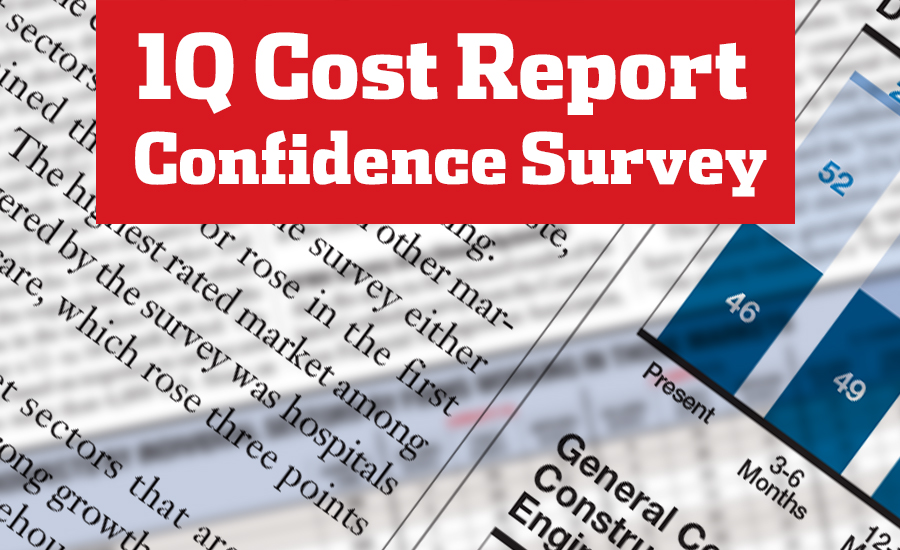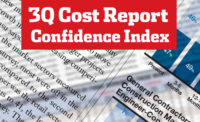The construction market currently is as robust as it has been in a decade, and it seems the near-term prospects continue to be positive. However, many construction executives are beginning to worry that the long-term market and business prospects may not be as rosy.
 The near-term optimism, blunted by a longer-term market concern, can be seen in the results of the ENR Construction Industry Confidence Index survey. The CICI rose two points, to 73, in the first quarter. Of the 281 executives of large construction and design firms responding to the survey, most believe market growth will continue at least through the end of 2018.
The near-term optimism, blunted by a longer-term market concern, can be seen in the results of the ENR Construction Industry Confidence Index survey. The CICI rose two points, to 73, in the first quarter. Of the 281 executives of large construction and design firms responding to the survey, most believe market growth will continue at least through the end of 2018.
But beyond that, the execs are less optimistic. For example, only 11% think it will be in decline in 12 to 18 months, compared with 37% who say it still will be in growth mode. But in three years, 29% expect a market decline, compared with 23% who believe it still will be growing.
The CICI measures executive sentiment about the current market and where it will be in the next three to six months and over a 12- to 18-month period. A rating above 50 indicates a growing market.
The index is based on responses to surveys sent out between Feb. 9 and March 12 to more than 6,000 U.S. firms on ENR’s candidate lists of leading general contractors, subcontractors and design firms.
CFMA: CFOs Wary of ‘Triple Whammy’
Some execs are beginning to see storm clouds on the horizon. Many already have been worrying about whether the market has reached its peak and will begin to contract. Further, the recently announced 25% tariffs on imported steel and 10% on imported aluminum may stall the market and put pressure on profits.
The soon-to-be-released results of the latest Confindex survey from the Construction Financial Management Association, Princeton, N.J., show that CFOs are increasingly worried about both the market and the business of construction in the near future.
Each quarter, CFMA polls 200 CFOs from general and civil contractors and subs. The CFMA Confindex is based on four separate financial and market components, each rated on a scale of one to 200. A rating of 100 indicates a stable market; higher ratings show market growth is anticipated.
“The overall Confindex dropped from 124 in the previous quarter to 116 in the current quarter,” says Stuart Binstock, CFMA’s CEO. All four components of the Confindex fell dramatically this quarter.
The “general business conditions” component fell 11 points, to 119, and the “current conditions” component dropped seven points to 123. Further, the “year-ahead outlook” fell nine points to 108, Binstock says, while the “financial conditions” component fell five points, to 114.
Binstock notes the Confindex survey was circulated after the Trump administration’s tariff announcement. He says the tariffs, coupled with concern about the possible end of the construction boom cycle and the failure of the administration to effectively press its infrastructure funding proposals is “a triple whammy” against continued market confidence.
The impact of the tariff announcement already may be having an effect, says Anirban Basu, CEO of economic consultant Sage Policy Group Inc., Baltimore. He says contractors at a recent conference in Philadelphia said their steel suppliers were hiking steel prices 9% and anticipated additional increases shortly.
“Many contractors have built up large backlogs, but those contracts generally were negotiated based on the lower steel prices before the tariffs were announced,” Basu says. Now contractors may start declining hard-bid opportunities until the steel prices shake out, he says.
Most Markets Continue to Thrive
While many firms are worried about the long term, the current market continues to thrive. The only sector that lost ground this quarter was water, sewer and waste, down two points to a 67 CICI rating.
The confidence levels in all other market sectors covered by the survey either remained the same or rose in the first quarter. The highest rated market among the 15 covered by the survey was hospitals and health care, which rose three points to a 74 rating.
Other market sectors that are perceived to be in a strong growth mode are distribution and warehouses, industrial and manufacturing and transportation, all of which had a CICI rating of 71, and the petroleum sector, which had a 70 rating.
The biggest gainer was the multiunit residential sector, rising seven points to a 62 rating, despite past fears that this market was running out of steam.
Some execs believe the recent tax-cut package may stir new private sector investment. However, they note the cuts have not resulted in any new work yet.
The CICI survey also asked execs whether their firms’ profit margins had changed over the past year. Only 11.7% said their margins were down, while 37.1% saw an increased profit margin.
However, CFMA members believe that the bottom line may be coming under siege. Binstock warns that increases in materials costs from high demand and the Trump tariffs may take their toll on profits. But CFMA members are most worried about labor costs. “Over 81% of our survey participants are ‘concerned’ or ‘very concerned’—four times the level of next biggest concern among our members,” says Binstock.






Post a comment to this article
Report Abusive Comment